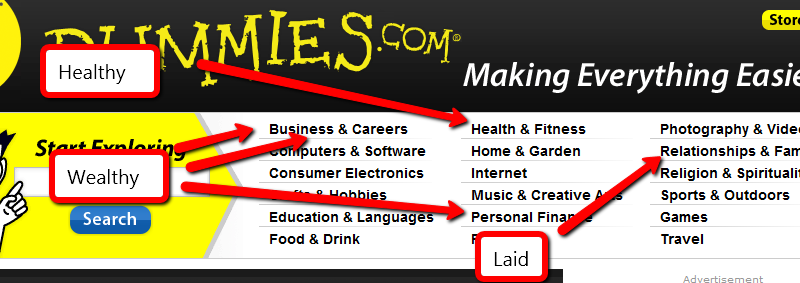What would your future-you have to say to you?
The no-pants guide to spending, saving, and thriving in the real world.
What would your future-you have to say to you?

Everyone needs an emergency fund. More than that, you will eventually need retirement savings, a new car, a big-screen TV, or maybe just a new kidney. Whatever the reason, one day, have a comfortable savings account will make your life easier.
But, Jason, you say, it’s hard to save money! How can I start saving when I can’t make ends meet? I’ve got rent, 9 kids, and a DVD addiction that won’t quit. My mortgage is underwater, my Mercedes still has 8 years on the loan, and the Shoe-of-the-Month Club only carries Christian Louboutin’s. What can I do?
Well, I’ll reply, since I am Jason and you asked for me by name, you need to find a way to make it happen. I’d never recommend someone give up their diamond-studded kicks, but something’s gotta give. In the meantime, there are some ways you can save money without feeling the sting of delayed gratification.
1. Save your raise. When you get your next raise, pretend you didn’t. Set up an automatic transfer to stick that new 5% straight into a savings account. Don’t give yourself an opportunity to spend it.
2. Find it, hide it. When your Aunt Gertrude dies and leaves your her extensive collection of California Raisins figurines, sell them and save the money. If you find a $20 bill on the ground, throw it right into your savings account. When your 30th lottery ticket of the week gives you a $10 prize, save it! Don’t waste found money on luxuries. Use it to build your future.
3. Let it lapse. Do you have magazine subscriptions you never read? Or a gym membership you haven’t used since last winter? Panty-of-the-Month? Crack dealer who delivers? Stop paying them! Let those wasted services fall to the wayside and put the money to better use. I don’t mean flipping QVC products on eBay, either. Save the money.
4. Jar of 1s. Roughly once a week, I dig through my pockets and my money clip looking for one dollar bills. Any that I find go in a box to be forgotten. I use that box as walking-around money for our annual vacation, but it could easily get repurposed as a temporary holding tank for money I haven’t gotten to the bank, yet.
5. Round it up. Do you balance your checkbook? If you don’t, start. If you do, start doing it wrong. Round up all of your entries to the nearest dollar. $1.10 gets recorded as $2. $25.75 goes in as $26. If you use your checkbook or debit card 100 times a month, that’s going to be close to $75 saved with absolutely no effort. It even makes recording your spending easier.
There you have it, 5 easy ways to save money that won’t cause you a moment’s pain.
Do you have any tricks to help you save money?

For the last year or so, I haven’t been writing much, which feels weird. I used to write three timer per week. I’d write about saving money, investing, frugality, sometimes, relationships and parenting.
But that stopped. Why?
When I started this site, I was about $110,000 in debt, and just starting my journey out of it. A few months before, I was looking into bankruptcy, because I didn’t know how to get out of debt.
For years, the ways I saved money, cut corners, and earned extra money was fodder for this site. Everything I did was about saving money, earning money, and paying off debt.
Now? I’m about 2 months away from being completely debt-free. I paid my mortgage off last month, and have about $10,000 in credit card debt at the moment. I know, I paid that off backwards, but there are reasons. Reasons I’ll share another time.
4 years ago, I was essentially working 4 jobs. My day job, my gun training business, my internet marketing business, and my websites(including this one). I was working all of the time. It was necessary, but it’s a path to burnout. Then, I changed jobs a couple of times, nearly doubling my day job’s pay. My business partner got promoted out of a position that generated leads for one of our businesses, then had an accident that the other shared business on hold for a while.
Suddenly, I had free time and enough money coming in that I didn’t need to work all of the time. It was a crazy place to be after spending more than a decade pretending to be a workaholic just to keep my head above water. (Here’s a secret: I’m incredibly lazy. I’m just the busiest lazy man I know.) So I started pursuing hobbies.
Linda and I have been taking ballroom dancing lessons and are nearly to the point that competing is a real possibility.
I cleaned out my garage and assembled a decent wood shop, which is something I’ve wanted to do roughly forever.
I’ve been taking blacksmithing lessons with my teenage son.
I’ve been playing games with my kids, dating my wife, and simply enjoying my life.
This site?
Through all of that, I haven’t known what to write about.
“Dear audience, this month, I paid my bills, didn’t go on vacation, and bought a drill press.”
“Dear audience, my debt went down another $500 this month.”
“Dear audience, I didn’t buy a car I can’t afford this month. Again.”
Those aren’t good articles. Financially–while paying off debt is disturbingly exciting–my life is very repetitive. That’s the hardest part about paying off a lot of debt. It’s good, it’s necessary, it’s boring. My wins have been spaced out by several years lately, and I haven’t been creatively frugal. Screw frugal. If you can afford some conveniences and luxuries, frugal sucks.
Anything new happening in my world that would apply to this site would make it read like an accountant’s ledger book. $100,000 minus $1500 plus $10,000 minus $300, ad nauseum.
Instead of inflicting boring accountancy on you, I’ve been absent.
What next? Who knows. I enjoy writing. I enjoy writing here. I’ve started writing a novel.
What would you like to see here?
When you accumulate a certain level of debt, it feels like you’re wading through an eyeball-deep pool of poo, dancing on your tiptoes just to keep breathing. Ask me how I really feel.
It shouldn’t be a surprise that I’m in debt. We have gone over this before. The story isn’t one of my proudest, so I’ve never talked much about how it happened.
Our debt was entirely our fault. We messed up and dug our own poo-pool. There were no major medical bills, no extended unemployment, just a strong consumer urge and an apparent need for instant gratification. Delayed gratification wasn’t a skill I’d considered learning. The idea of it was a thoroughly foreign concept. Why wait when every store we visited offered no payments/no interest for a year? We didn’t give much thought to what would happen when the year was up.
We got married young. We bought our house young. We started our family young. We did all of that over the course of two years, well before we were financially ready. Twenty years old, we had excellent credit and gave our credit reports a workout. Credit was so easy to get. By the time I was 22, we had a total credit limit more than twice our annual income. We fought so hard to keep up with the Joneses. A new pickup, a remodel on our house. Within a month of paying off the truck, I got a significant raise and rushed out to buy a new car.
Every penny that hit the table was caught in a net of lifestyle expansion. I was bouncing on my tiptoes.
Four months into my new car payment, I was laid off. There’s me, hoping for a snorkel. A week later, we found out our son was going to be a big brother. Our pool had developed a tide.
We killed the cable and cut back on everything else and…managed. Money was tight, but we got by. I got a new job, but had we learned any lessons? Of course not. We got a satellite dish, started shopping the way we always had. Times were good, and could never be bad. We had such short memories.
Fast forward a couple of years. Baby #3 is on the way while baby #2 is still in diapers. Daycare was about to double. Daddy started to panic. I built a rudimentary budget and realized there was no way to make ends meet. There just wasn’t enough cash coming in to cover expenses. That’s when I made my first frugal decision: I quit smoking. That cut the expenses right to the level of our income. It was tight, but doable.
There was still one serious problem. Neither one of us could control our impulse shopping. For a time, I was getting packages delivered almost every day. It was never anything expensive, but it was always something. Little things add up quickly.
Last spring, I realized we couldn’t keep going like that. I started looking into bankruptcy. Somehow, we managed to toss ourselves into the deep end of the pool. We had near-perfect credit and no way to maintain it.
While researching bankruptcy, I found our life preserver. We put together a budget. We cut and…it hurt. It’s taken a year, but every bill we have is finally being tracked. We have an emergency fund and we are working towards our savings goals. It hasn’t been an easy year, but we are making progress. We’ve eliminated 15% of our debt and opened out budget to include some “blow money” and an occasional date night. We are always looking for ways to decrease our bottom line and increase the top line. Most important, we are actually working together to keep all of our expenses under control, with no hurt feelings when we remind ourselves to stay on track.
We are finally standing flat-footed, head and shoulders above the poo.
Update: This post has been included in the Carnival of Personal Finance.

In this installment of the Make Extra Money series, I’m going to show you how to set up a WordPress site. I’m going to show you exactly what settings, plugins, and themes I use. I’m not going to get into writing posts today. That will be next time.
I use WordPress because it makes it easy to develop good-looking sites quickly. You don’t have to know html or any programming. I will be walking through the exact process using Hostgator, but most hosting plans use CPanel, so the instructions will be close. If not, just follow WordPress’s 5 minute installation guide.
Assuming you can follow along with me, log in to your hosting account and find the section of your control panel labeled “Software/Service”. Click “Fantastico De Luxe”.

On the Fantastico screen, click WordPress, then “New Installation”.

On the next screen, select your domain name, then enter all of the details: admin username, password, site name, and site description. If you’ll remember, I bought the domain http://www.masterweddingplanning.net. I chose the site name of “Master Wedding Planning” and a description of “Everything You Need to Know to Plan Your Wedding”.
Click “install”, then “finish installation”. The final screen will contain a link to the admin page, in this case, masterweddingplanning.net/wp-admin. Go there and log in.
After you log in, if there is a message at the top of the screen telling you to update, do so. Keeping your site updated is the best way to avoid getting hacked. Click “Please update now” then “Update automatically”. Don’t worry about backing up, yet. We haven’t done anything worth saving.
Next, click “Settings” on the left. Under General Settings, put the www in the WordPress and site URLs. Click save, then log back in.
Click Posts, then Categories. Under “Add New Category”, create one called “Misc” and click save.
Click Appearance. This brings you to the themes page. Click “Install Themes” and search for one you like. I normally use Headway, but before I bought that, I used SimpleX almost exclusively. Your goal is to have a simple theme that’s easy to maintain and easy to read. Bells and whistles are a distraction.

Click “Install”, “Install now”, and “Activate”. You now have a very basic WordPress site.
A plugin is an independent piece of software to make independent bits of WordPress magic happen. To install the perfect set of plugins, click Plugins on the left. Delete “Hello Dolly”, then click “Add new”.
In the search box, enter “plugin central” and click “Search plugins”. Plugin Central should be the first plugin in the list, so click “install”, then “ok”, then “activate plugin”. Congratulations, you’ve just installed your first plugin.
Now, on the left, you’ll see “Plugin Central” under Plugins. Click it. In the Easy Plugin Installation box, copy and paste the following:
All in One SEO Pack Contact Form 7 WordPress Database Backup SEO SearchTerms Tagging 2 WP Super Cache Conditional CAPTCHA for WordPress date exclusion seo WP Policies Pretty Link Lite google xml sitemaps Jetpack by WordPress.com
Click “install”.
On the left, click “Installed Plugins”. On the next screen, click the box next to “Plugins”, then select “Activate” from the dropdown and click apply.

Still under Plugins, click “Akismet Configuration”. Enter your API key and hit “update options”. You probably don’t have one, so click “get your key”.
The only tool I worry about is the backup. It’s super-easy to set up. Click “Tools”, then “Backup”. 
Scroll down to “Schedule Backups”, select weekly, make sure it’s set to a good email address and click “Schedule Backup”. I only save weekly because we won’t be adding daily content. Weekly is safe enough, without filling up your email inbox.
There are a lot of settings we’re going to set. This is going to make the site more usable and help the search engines find your site. We’re going to go right down the list. If you see a section that I don’t mention, it’s because the defaults are good enough.
Set the Default Post Category to “Misc”.
Visit this page and copy the entire list into “Update Service” box. This will make the site ping a few dozen services every time you publish a post. It’s a fast way to get each post indexed by Google.
Click “Save Changes”.
Uncheck everything under “Email me whenever…” and hit save. This lets people submit comments, without actually posting the comments or emailing me when they do so. Every once in a while, I go manually approve the comments, but I don’t make it a priority.
Select “Custom structure” and enter this: /%postname%/
Click save.
Set the status to “Enabled”, then fill out the site title and description. Keep the description to about 160 characters. This is what builds the blurb that shows up by the link when you site shows up in Google’s results.
Check the boxes for “Use categories for META keywords” and “Use noindex for tag archives”.
Click “Update Options”.
Check the boxes to remove each of the dates and set the alt text to “purpose” or something. This will suppress the date so your posts won’t look obsolete.

This plugin reinforces the searches that bring people to your site. It’s kind of neat. Skip the registration, accept the defaults and hit save.
Scroll to the bottom and click import. We’ll come back to this.
Select “Caching On” and hit save.
Across the top of the screen should be a giant banner telling you to connect to WordPress.com and set up Jetpack. You’ll need an account on WordPress.com, so go there and set one up. After authorizing the site, you’ll be brought back to the Jetpack configuration screen. Click “Configure” under “WordPress.com Stats”. Take the defaults and hit save.
On the contact configuration page, copy the code in the top section. You’ll need this in a moment.

Now, we going to create a couple of static pages. On the left, click “Pages”, then “Add new”.
Name the first page “Contact” and put the contact form code in the body of the page. Hit publish.
Under Appearance, click “Menu”. Enter a menu name and hit save.
Then, under “Pages”, click the box next to “Contact”, “Disclaimer”, and any other policies you’d like to display. Hit save.
Also under Appearance, click “Widgets”. This is where you’ll select what will display in the sidebar. All you have to do is drag the boxes you want from the middle of the page to the widget bar on the right. I recommend Text, Search, Recent Posts, Popular Search Terms and Tag Cloud. In the text box, just put some placeholder text in it, like “Product will go here”. We’ll address this next time.
We’re not going to worry about getting posts in place, yet. That will be the next installment. However, the steps in the next installment could take 2 weeks to implement, and we want Google to start paying attention now. To make that happen, we need to get a little bit of content in place. This won’t be permanent content. It’s only there so Google has something to see when it comes crawling.
To get this temporary, yet legal content, I use eZineArticles. Just go search for something in your niche that doesn’t look too spammy.
Then, click “Posts”, then delete the “Hello World” post. Click “Add new”. Copy the eZine article, being sure to include the author box at the bottom, and hit publish.
To see your changes, you may have to go to Settings, then WP Cache and delete the cache so your site will refresh.
Congratulations! You now have a niche blog with content. It’s not ready to make you any money, yet, but it is ready for Google to start paying attention. In the next installment, I’ll show you how I get real unique content and set it up so Google keeps coming back to show me the love.

If you want to make money, help someone get healthy, wealthy or laid.
This section was quick.
Seriously, those three topics have been making people rich since the invention of rich. Knowing that isn’t enough. If you want to make some money in the health niche, are you going to help people lose weight, add muscle, relieve stress, or reduce the symptoms of some unpleasant medical condition? Those are called “sub-niches”. (Side question: Viagra is a sub-niche of which topic?)
Still not enough.
If you’re going to offer a product to help lose weight, does it revolve around diet, exercise, or both? For medical conditions, is it a way to soothe eczema, instructions for a diabetic diet, a cure for boils, or help with acne? Those are micro-niches.
That’s where you want to be. The “make money” niche is far too broad for anyone to effectively compete. The “make money online” sub-niche is still crazy. When you get to the “make money buying and selling websites” micro-niche, you’re in a territory that leaves room for competition, without costing thousands of dollars to get involved.
Remember that: The more narrowly you define your niche market, the easier it is to compete. You can take that too far. The “lose weight by eating nothing but onions, alfalfa, and imitation caramel sauce” micro-niche is probably too narrowly defined to have a market worth pursuing. You need a micro-niche with buyers, preferably a lot of them.
Now the hard part.
How do you find a niche with a lot of potential customers? Big companies pay millions of dollars every year to do that kind of market research.
Naturally, I recommend you spend millions of dollars on market research.
No?
Here’s the part where I make this entire series worth every penny you’ve paid. Times 10.
Steal the research.
My favorite source of niche market research to steal is http://www.dummies.com/. Click the link and notice all of the wonderful niches at the top of the page. Jon Wiley & Sons, Inc. spends millions of dollars to know what topics will be good sellers. They’ve been doing this a long time. Trust their work.

You don’t have to concentrate on the topics I’ve helpfully highlighted, but they will make it easier for you. Other niches can be profitable, too.
Golf is a great example. Golfers spend money to play the game. You don’t become a golfer without having some discretionary money to spend on it. I’d recommend against consumer electronics. There is a lot of competition for anything popular, and most of that is available for free. If you choose to promote some high-end gear using your Amazon affiliate link, you’re still only looking at a 3% commission.
I like to stick to topics that people “need” an answer for, and can find that answer in ebook form, since I will be promoting a specific product.
With that in mind, pick a topic, then click one of the links to the actual titles for sale. The “best selling titles” links are a gold mine. You can jump straight to the dummies store, if you’d like.
Of the topics above, here’s how I would narrow it down:
1. Business and Careers. The bestsellers here are Quickbooks and home buying. I’m not interested in either topic, so I’ll go into “More titles”. Here, the “urgent” niches look like job hunting and dealing with horrible coworkers. I’m also going to throw “writing copy” into the list because it’s something I have a hard time with.

2. Health and Fitness. My first thought was to do a site on diabetic cooking, but the cooking niche is too competitive. Childhood obesity, detox diets and back pain remedies strike me as worth pursuing. I’m leaning towards back pain, because I have a bad back. When you’ve thrown your back out, you’ve got nothing to do but lie on the couch and look for ways to make the pain stop. That’s urgency.
3. Personal Finance. The topics that look like good bets are foreclosures and bankruptcies. These are topics that can cost thousands of dollars if you get them wrong. I hate to promote a bankruptcy, but some people are out of choices. Foreclosure defense seems like a good choice. Losing your home comes with a sense of urgency, and helping people stay in their home makes me feel good.
4. Relationships and Family. Of these topics, divorce is probably a good seller. Dating advice definitely is. I’m not going to detail either one of those niches here. Divorce is depressing and sex, while fun, isn’t a topic I’m going to get into here. I try to be family friendly, most of the time. Weddings are great topic. Brides are planning to spend money and there’s no shortage of resources to promote.
So, the niches I’ve chosen are:
I won’t be building 9 niche sites in this series. From here, I’m going to explore effective keywords/search terms and good products to support. There’s no guarantee I’ll find a good product with an affiliate program for a niche I’ve chosen that has keywords that are both highly searched and low competition, so I’m giving myself alternatives.
For those of you following along at home, take some time to find 5-10 niches you’d be willing to promote.
The important things to consider are:
1. Does it make me feel dirty to promote it?
2. Will there be customers willing to spend money on it?
3. Will those customers have an urgent need to solve a problem?
I’ve built sites that ignore #3, and they don’t perform nearly as well as those that consider it. When I do niche sites, I promote a specific product. It’s pure affiliate marketing, so customers willing to spend money are necessarily my target audience.